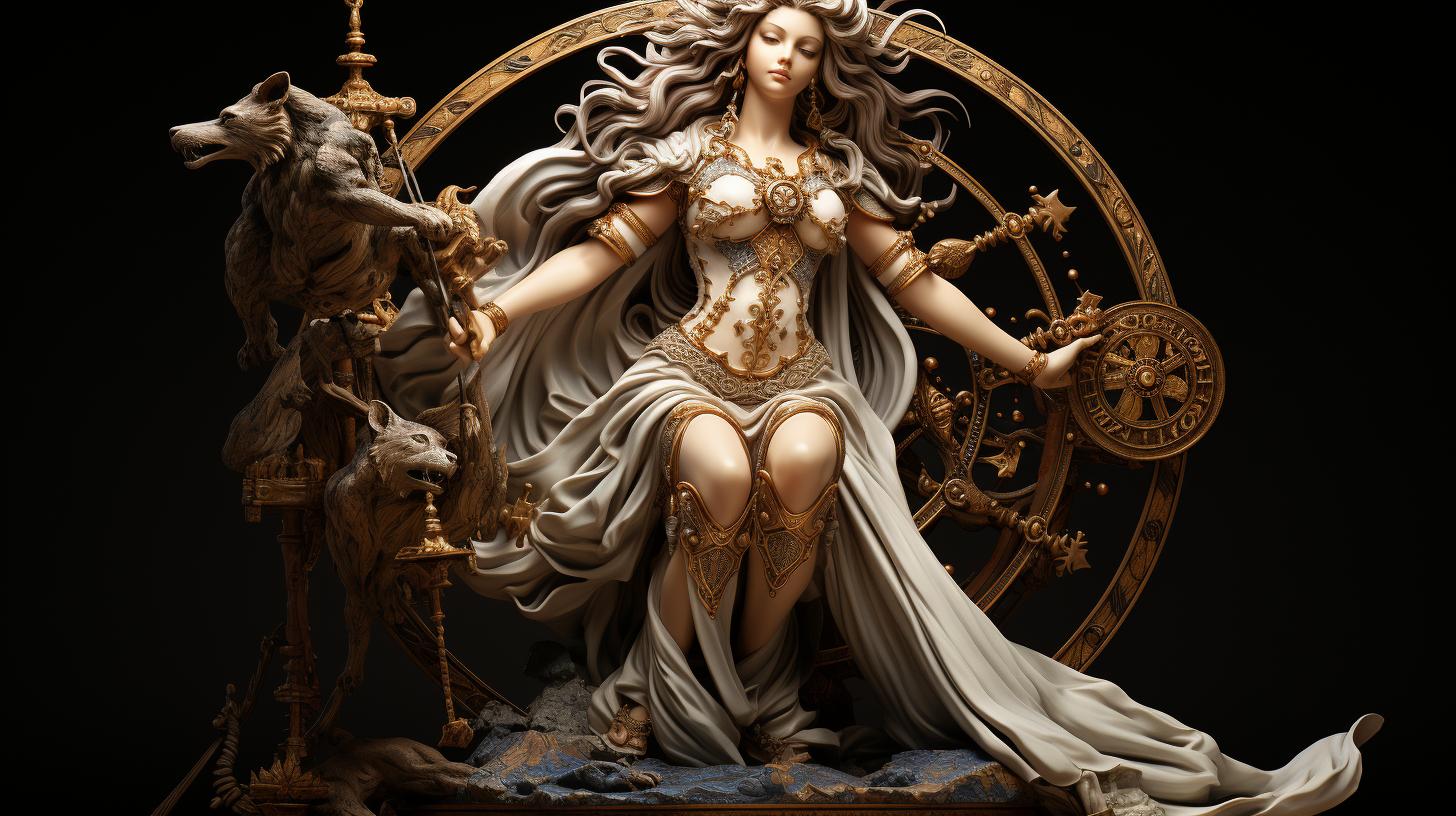Roman Goddess Clementia: The Symbol of Mercy and Compassion in Ancient Rome

Roman Goddess Clementia holds a significant place in ancient Roman religion and society. Originating as a symbol of mercy and compassion, Clementia became deified and associated with Julius Caesar. Art and coins depict her holding symbols of peace and victory.
Romans regularly invoked her for forgiveness and mercy, and her cult extended beyond Julius Caesar to other emperors. This article explores the origins, representations, and role of Clementia in Roman society, as well as its enduring legacy in shaping Western ideals.
Join us on this journey to unravel the captivating story of Roman Goddess Clementia.
Roman Goddess Clementia: Exploring the Symbol of Mercy and Compassion
In Roman religion, the goddess Clementia held a significant role as the embodiment of mercy and compassion. Understanding the origins and significance of Clementia provides valuable insights into the religious beliefs of the ancient Romans.
The Origins and Significance of Clementia in Roman Religion
Within the Roman pantheon, Clementia emerged as a distinct deity representing mercy and compassion. Her worship held deep roots in the Roman culture, often associated with the virtues upheld by the society.
The Romans believed in the importance of showing mercy towards others, and Clementia personified this essential attribute.
Clementia and the Deification of Julius Caesar
Julius Caesar, a prominent and influential figure in ancient Rome, played a significant role in the veneration of Clementia. As he ascended to power, Caesar’s virtuous qualities were celebrated, and he became closely associated with Clementia.
This connection led to his deification and further solidified the representation of mercy and compassion in the persona of Clementia.
Representations of Clementia in Roman Art and Coins
These representations commonly showed her standing, holding a patera (a shallow dish) in one hand, while carrying a scepter in the other, symbolizing her authority and mercy.
- Represented with a patera and scepter.
- Pose often depicted as standing.
- Symbolic elements highlighting authority and mercy.
Additionally, Clementia could also be portrayed seated, holding a laurel branch or an olive branch, emblematic of peace and victory.
These artistic representations aimed to convey the essence of Clementia and her benevolent nature.
.
Continuing the exploration of Roman Goddess Clementia, the following sections will delve into her role in Roman society, shedding light on the significance of invoking Clementia and her influence on rulers of the time.
Stay tuned for an enlightening journey through the cultural impact of this revered deity.
The Role of Clementia in Roman Society
The role of Clementia, the Roman goddess of mercy and compassion, was deeply intertwined with the societal values and practices of ancient Rome. This section explores the significant aspects related to Clementia’s role in Roman society, including the act of invoking her for seeking forgiveness and showing mercy, the influence of Clementia within the cult of Julius Caesar, and her impact on the subsequent emperors.
Invoking Clementia: Seeking Forgiveness and Showing Mercy
One of the primary functions of Clementia in Roman society was to provide a means for individuals to seek forgiveness and demonstrate mercy towards others. Romans believed that by invoking Clementia, they could appeal to her divine mercy and compassion, hoping to receive clemency for their transgressions.
This act of seeking forgiveness and mercy played a crucial role in maintaining social harmony and reinforcing moral values.
When individuals found themselves facing difficult decisions or conflicts, they would often turn to Clementia as a symbol of guidance and leniency. By seeking her favor, they hoped to resolve disputes amicably, avoid unnecessary hardships, and foster a sense of unity among the Roman people.
Julius Caesar, a prominent figure in Roman history, played an integral part in promoting the worship and influence of Clementia. His deification was closely associated with the goddess, establishing a powerful connection between his rule and the virtues she represented.
In the wake of his assassination, the cult of Clementia grew in prominence, with temples and altars dedicated to both Caesar and Clementia.
The cult of Clementia within the context of Julius Caesar aimed to highlight his qualities as a leader benevolent towards his enemies and a dispenser of mercy. By aligning himself with Clementia, Caesar presented himself as a ruler who prioritized forgiveness and compassion, seeking to maintain stability within the Empire.
The Influence of Clementia on Subsequent Emperors
The cult of Clementia, established in conjunction with Julius Caesar, extended its influence beyond his era and affected subsequent emperors in their rule. Following the example set by Caesar, many emperors sought to associate themselves with Clementia, presenting themselves as benevolent rulers.
They utilized her symbolic representation of mercy and compassion as a means to legitimize their authority and win the support of the Roman populace.
Emperor Tiberius and Caligula were among those honored with altars dedicated to their clemency, emphasizing their commitment to the virtues embodied by Clementia. The influence of Clementia on subsequent emperors demonstrated the enduring significance of her role in shaping Roman governance and the perception of leadership within the empire.
- Key Points:
- Clementia offered a means for forgiveness and mercy in Roman society.
- Invoking Clementia was important for resolving conflicts and maintaining social harmony.
- Julius Caesar played a significant role in promoting the worship of Clementia.
- The influence of Clementia extended to subsequent emperors, influencing their rule and perception.
The Legacy of Clementia in History
The legacy of Clementia, the Roman goddess of mercy and compassion, extends far beyond ancient Rome, leaving a lasting impact on Western ideals.
This section explores the various aspects of her legacy and how it has influenced society throughout history.
Clementia as a Virtue in Ancient Roman Society
In ancient Roman society, Clementia was highly regarded as a virtue, embodying the ideals of mercy, forgiveness, and compassion. The Romans saw these qualities as essential for maintaining a harmonious society and fostering leadership grounded in fairness and understanding.
Clementia represented the capacity to show leniency and grant mercy, a crucial attribute for individuals in positions of power.
Clementia aspired to create a sense of empathy and humanity in Roman society, encouraging individuals to treat one another with compassion and understanding. It was believed that practicing Clementia would contribute to social harmony and reinforce the values that held the Roman Empire together.
Clementia as a Symbol of Roman Power and Authority
Beyond being a virtue, Clementia also held significant symbolism within the Roman Empire, representing the power and authority of its leaders. Emperors often associated themselves with Clementia to portray themselves as just and merciful rulers.
By showcasing their commitment to Clementia, they aimed to forge a bond with their subjects and secure their loyalty.
Clementia became an emblem of Roman might and influence, serving as a reflection of the empire’s strength and benevolence. It symbolized the capacity of Rome to conquer not only through military force but also through compassion and understanding.
The depiction of Clementia in art and on coins further solidified its role as a symbol of Roman power and authority.
Continuity and Adaptation: Clementia in Modern Western Ideals
The influence of Clementia has survived beyond the fall of the Roman Empire and continues to resonate in modern Western ideals. The concept of mercy, compassion, and forgiveness has remained integral to moral and ethical frameworks within Western societies.
Over the centuries, different cultures and societies have adapted and reinterpreted the concept of Clementia to fit their own understandings of compassion and mercy. From a historical standpoint, Clementia serves as a foundation for discussions on justice, fairness, and the importance of moral responsibility in governance.
Incorporating the principles of Clementia into governance and social systems has become a cornerstone of promoting peace, understanding, and justice. The legacy of Clementia endures as a reminder of the enduring importance of empathy and mercy in shaping a just and compassionate society.
As we analyze the legacy of Clementia in history, it becomes evident that her influence stretches far beyond ancient Rome, leaving an indelible mark on Western civilization. The virtues she embodied, the symbolism she represented, and the adaptability of her principles continue to shape our collective understanding of compassion, mercy, and justice.
- Clementia’s role as a virtue in Roman society
- Clementia as a symbol of Roman power and authority
- Continuity and adaptation of Clementia in modern Western ideals…..




















